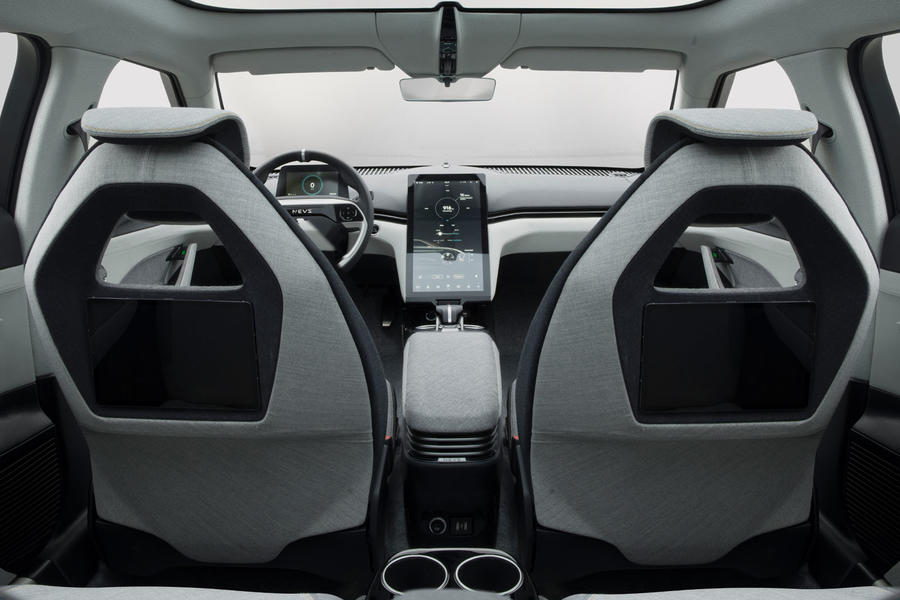Emily GT was said to be 1.5 years from being production-ready | Image: Plint Marketing
Radical 621-mile electric saloon, developed by former Saab engineers, moves a step closer to production
The Nevs Emily GT, a 621-mile electric saloon developed by engineers from Saab, has taken a step closer to production after the project was bought by Canadian start-up EV Electra.
The striking EV was revealed to the world by Nevs engineers in April, after the Swedish firm was placed in “hibernation mode” by its Chinese owner, Evergrande Group.
Nevs acquired the rights to many of Saab’s assets when the storied brand entered bankruptcy in 2012 and is based in Saab’s old home city of Trollhättan.
In a statement, Nevs CEO Nina Selander hailed EV Electra’s acquisition of the Emily GT – as well as the Nevs Pons autonomous pod – as a “realisation of shared dreams” and a “profound moment”.
The joint statement added that EV Electra will soon begin assembling its first cars at a factory in Turkey.
EV Electra founder and CEO Jihad Mohammad said: “We will have cars coming out of Trollhättan again.
“We did this acquisition fully aware that we will need to back it all the way through development to mass production.
“I’m a firm believer in in-house production and strong balance sheets. I also believe Trollhättan has the personnel that can make our visions come true.
“The acquisition of the Pons and Emily projects signifies a pivotal milestone in our pursuit of innovation and sustainability. We’re thrilled to embark on this journey.”
What is the Nevs Emily GT?
![]()
The Nevs Emily GT is a four-door, five-seat electric car rivalling the Mercedes-Benz EQS and Tesla Model S.
It is claimed to be capable of driving more than 1000km (621 miles) between charges, thanks to a huge 175kWh battery.
Battery capacities of 140kWh and 105kWh were also in the original plans, as was 11kW wireless charging via a pad connected to a fixed hub.
The Emily prototypes used a 52kWh battery from the Nevs 9-3, an electric conversion of the Saab of the same name.

In-wheel motors making 121bhp are mounted at each corner, giving the Emily GT 484bhp in total.
Each motor sandwiches a drive unit between the alloy wheel and the aluminium brake disc, reportedly giving finer control of torque vectoring.
Such was the extent of the vectoring that the car can turn without using the steering wheel.
An air suspension system with active dampers was utilised to counteract the negative effect on ride quality caused by the increase in unsprung weight from the in-wheel motors.

A high-performance variant of the Emily GT was also in the works, with planned outputs of 653bhp and 1623lb ft. This would cut its 0-62mph sprint time down from 4.6sec to 3.2sec.
It has yet to be announced whether EV Electra will change these specifications.
The striking styling – which bears a strong resemblance to the final Saab 9-3 and Saab 9-5 – is reported to have been penned by an unnamed Italian and refined by former Saab designers.
Nevs’ owner, the Evergrande Group, originally signed off a run of 20 prototypes. However, Evergrande – which made its fortune as one of China’s most prolific property developers – hit financial problems in 2020, and only six were built.

In April, Emily programme director and former Saab engineer Peter Dahl told Swedish publication Carup: “Everything is in place to take it further into production. The prototypes are completely drivable, except that the airbag and auto-braking systems are missing.”
Dahl said the project was about a year and a half away from completion.
Evergrande put Nevs into “hibernation” in April, having failed to secure a buyer. Of the Swedish firm’s 340 employees, 320 were laid off.
That month, Polestar signed a lease for part of Nevs’s Trollhättan factory. The Volvo spin-off will use the facility as an R&D base for its future EVs.
Source: Autocar
